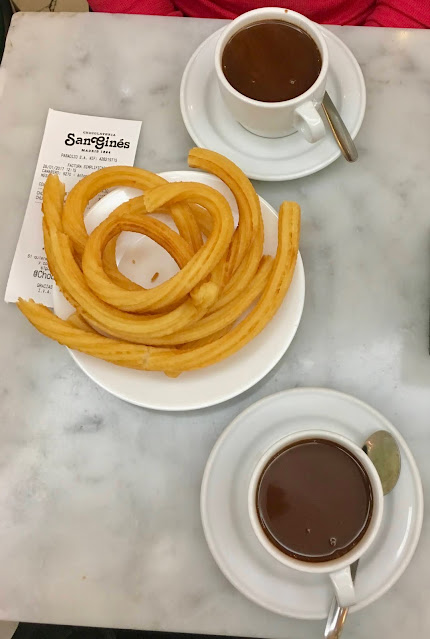Ever since the Inquisition, ham has been a major pillar of Spanish cuisine. Marranos (Jews who were forced to convert to Christianity) ate ham to show that they were not secretly keeping kosher. Christians also ostentatiously ate ham to avoid being denounced as Jews.
Once established, the taste for cured pig meat has become an obsession, even an art form.

There are at least eleven Ham Museums (really just a chain of restaurants specializing in various ham concoctions) in Madrid alone. And that's just the one chain.

Walking through the city, it seems that there is at least one ham store per block, not even counting the restaurants, bars, bodegas, cervecerias, etc. that, though they may not be ham specialists, certainly have an extensive number of ham plates and ham-infused dishes on their menus.
So what's all the fuss about?
The two main types of Spanish ham are jamón ibérico and jamón serrano. Serrano comes from white pigs raised in the the Spanish sierras. It's considered to be of lesser quality than jamón ibérico, and so is cheaper and more widely consumed. It is still delicious.
Jamón ibérico is made from black Iberian pigs, or pata negra (black toenails). It's believed that this breed was introduced by the Phoenicians, who then interbred them with native wild boars. A single leg of the best ham can cost about $500, or about $30/pound, The back legs of the pig are considered the best quality.`
The distinctive flavor of the Iberian ham starts with the way the pigs are raised and fed. This process is legally regulated to ensure the highest quality. Immediately after they are weaned, the piglets are fattened on grain for several weeks. As they grow, they are free to roam in pastures and oak groves, eating only natural forage, until they are almost ready for slaughter.
At that point, they are fed only olives or acorns from the huge Holm, Gall, or Cork oak trees that dot the plains of central and southern Spain. This diet gives the meat a rich, nutty umami, enhanced by streaks of buttery fat.
The hams are cured by being salted and dried repeatedly in a process that takes at least a year, although the very best are cured for as much as four years.
The three main types of jamón ibérico are:
Jamón ibérico de bellota (acorn): This is considered the very finest quality ham, made from free range pigs and cured for at least 36 months.
Jamón de Recebo: Made from pigs that are pastured and fed a mixed diet of acorns and grain. Must be cured for at least 24 months.
Jamón Ibérico de Cebo: Made from grain-fed pigs and cured for up to 24 months.
Until 2007, jamón ibérico was not available in the United States, and there are still only two producers in Spain that are allowed to export to the States. So if you want to experience the best Iberian hams, you have to come to Spain.

The quality of the meat is only part of the reason why Iberian ham is best enjoyed in Spain. The second reason is the ham slicer or cortador.
A master cortador is a respected member of the Spanish culinary scene, considered more an artist than a kitchen worker. There are only about a hundred full-time cortadores in the country, and they make a good living slicing hams.
Florencio Sanchidrián, considered by many the finest cortador in the world, charges around $4,000 to slice a single ham, about an hour and a half's work. He has flown all over the world to slice ham at high-end restaurants and private parties
As you can imagine, cortador is a highly-coveted position. A minimum of three years is needed to be certified, and an annual competition for cortadores is followed avidly by pig aficionados.
Slicing the ham correctly brings out all its many flavors. Each slice must be of a certain thickness and contain just the right balance of meat and fat.
The process starts with a long, flexible slicing knife that cuts the meat just thinly enough that the fat melts slightly onto the blade. Slicing machines are never used because the machine’s blades get hot and can destroying the delicate aromas and flavors of the tocino, or ham fat. A knife produces just enough warmth to release the fat’s full aroma.
Ideally, the ham should be cut seconds before it is consumed to ensure that its aroma, flavor, and texture are at their peak. As a cut ham ages, it oxidizes and dries out, which changes its texture and makes it taste saltier.

That doesn't stop Spaniards from consuming pre-sliced ham in a dizzying number of ways, including this delicious, convenient hand-portable form.

But the best way to enjoy this uniquely Spanish delicacy is to belly up to a bar that employs a master cortador, like Joselito at Taverna Real, and order a plate of their finest jamón ibérico de bellota with toasts spread with pureed tomatoes and a glass of Miro vermut rojo from the tap to wash it all down.
P.





























